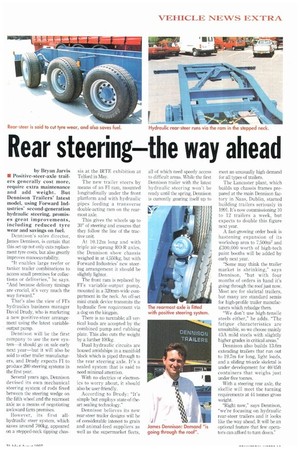Rear steering the way ahead
Page 17

If you've noticed an error in this article please click here to report it so we can fix it.
by Bryan Jarvis • Positive-steer-axle trailers generally cost more, require extra maintenance and add weight. But Dennison Trailers' latest model, using Forward Industries' second-generation hydraulic steering, promises great improvements, including reduced tyre wear and savings on fuel.
Dennison's sales director, James Dennison, is certain that this set-up not only cuts replacement tyre costs, but also greatly improves manoeuvrability.
"It enables large reefer or tanker trailer combinations to access small premises for collections or deliveries," he says. "And because delivery timings are crucial, it's very much the way forward."
That's also the view of FI's hydraulics business manager David Drudy, who is marketing a new positive-steer arrangement using the latest variableoutput pump.
Dennison will be the first company to use the new system—it should go on sale early next year—but it will also be sold to other trailer manufacturers, and Drudy expects Fl to produce 200 steering systems in the first year.
Several years ago, Dennison devised its own mechanical steering system of rods fixed between the steering wedge on the fifth wheel and the rearmost axle as a means of negotiating awkward farm premises.
However, its first allhydraulic steer system, which saves around 700kg, appeared on a stepped-neck tipping chas sis at the IRTE exhibition at Telford in May.
The new trailer steers by means of an Fl ram, mounted longitudinally under the front platform and with hydraulic pipes feeding a transverse double-acting ram on the rearmost axle.
This gives the wheels up to 30° of steering and ensures that they follow the line of the tractive unit.
At 10.12m long and with triple air-sprung RO-R axles, the Dennison show chassis weighed in at 4,550kg, but with Forward Industries' new steering arrangement it should be slightly lighter.
The front ram is replaced by FI's variable-output pump, mounted in a 320mm-wide compartment in the neck. An off-set mini crank device transmits the hydraulic flow requirement via a dog on the kingpin.
There is no turntable; all vertical loads are accepted by the combined pump and rubbing plate. This also cuts the weight by a further 100kg.
Dual hydraulic circuits are housed amidships in a manifold block which is piped through to the rear steering axle. It's a sealed system that is said to need minimal attention.
With no electrics or electronics to worry about, it should also be user-friendly.
According to Drudy: "It's simple but employs state-of-theart sealing technology."
Dennison believes its new rear-steer trailer designs will be of considerable interest to grain and animal-feed suppliers as well as the supermarket fleets, all of which need speedy access to difficult areas. While the first Dennison trailer with the latest hydraulic steering won't be ready until the spring, Dennison is currently gearing itself up to meet an unusually high demand for all types of trailers.
The Lancaster plant, which builds up chassis frames prepared at the main Dennison factory in Naas, Dublin, started building trailers seriously in 199L It's now commissioning 10 to 12 trailers a week, but expects to double this figure next year.
A fast-growing order book is hastening expansion of its workshop area to 7,500m2 and £300,000 worth of high-tech paint booths will be added by early next year.
"Some may think the trailer market is shrinking," says Dennison, "but with four months of orders in hand it's going through the roof just now. Most are for skeletal trailers, but many are standard semis for high-profile trailer manufacturers which rebadge them.
"We don't use high-tensile steels either," he adds. "The fatigue characteristics are unsuitable, so we choose mainly 43A mild steels with slightly higher grades in critical areas."
Dennison also builds 13.6m extending trailers that run out to 19.7m for long, light loads, and a sliding tri-axle skeletal is under development for 40/45ft containers that weighs just under five tonnes.
With a steering rear axle, the skellie will meet the turning requirements at 44 tonnes gross weight.
"Right now," says Dennison, "we're focusing on hydraulic rear-steer trailers and it looks like the way ahead. It will be an optional feature that few operators can afford to turn clown."




































































































